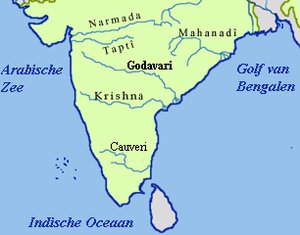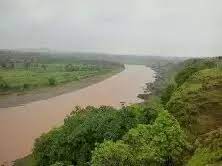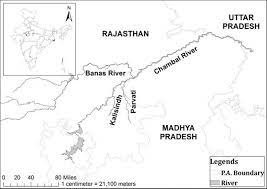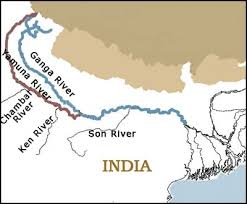Madhya Pradesh has a diverse topography that includes plateaus, plains, and river valleys. The drainage system in Madhya Pradesh is mainly characterized by its river network, which plays a crucial role in the state’s agriculture, economy, and overall development.

Table of Contents
Rivers in Madhya Pradesh
Narmada River: Narmada is one of the major rivers flowing through Madhya Pradesh. It originates in the Amarkantak Plateau and flows westward, dividing the state into two distinct physiographic regions – the Vindhya Range in the north and the Satpura Range in the south. The Narmada has several tributaries in Madhya Pradesh, contributing to the state’s drainage.

Tapti River: Tapti is another significant river in Madhya Pradesh. It flows through the northern part of the state, draining into the Arabian Sea. The Tapti River basin covers parts of the Nimar region in Madhya Pradesh.

Chambal River: Chambal is a tributary of the Yamuna River and flows through the northern part of Madhya Pradesh. The Chambal basin is crucial for irrigation and also supports wildlife sanctuaries along its course.

Son River: The Son River, a major tributary of the Ganges, flows through the northeastern part of Madhya Pradesh. It contributes to the state’s drainage and irrigates agricultural lands.

Betwa River:
Origin: The Betwa River originates near Hoshangabad in Madhya Pradesh.
Flow: It flows northward and joins the Yamuna River in Uttar Pradesh.
Dams: The Rajghat Dam and the Matatila Dam are important water management structures on the Betwa.
Ken River:
Origin: The Ken River originates in the Bundelkhand region of Madhya Pradesh.
Flow: It flows northwards and is a tributary of the Yamuna River.
Dams: The Ken-Betwa Link Project aims to interlink the Ken and Betwa rivers for water management and irrigation.
Shipra River:
Origin: The Shipra River originates from the Vindhya Range, near the Brahmagiri hills in Dhar district.
Flow: It flows in a northerly direction through the Malwa region, passing through the city of Ujjain, and eventually joins the Chambal River.
Choral River:
Origin: The Choral River has its origin in the Malwa Plateau in the Mhow Tehsil of Indore district.
Flow: It flows in a northeasterly direction and is a tributary of the Kshipra River.
Kali Sindh River:
Origin: The Kali Sindh River originates in the Malwa region, near the Indore district.
Flow: It flows in a northerly direction and is a major tributary of the Chambal River.
Parbati River:
Origin: The Parbati River originates in the Vindhya Range in the Damoh district.
Flow: It flows northeast and eventually joins the Chambal River in the northern part of Madhya Pradesh.
Banas River:
Origin: The Banas River originates in the Malwa region, near the Banswara district in Rajasthan.
Flow: It flows northward and is a significant tributary of the Chambal River.
Sukri River:
Origin: The Sukri River originates in the Satpura Range in the Hoshangabad district.
Flow: It flows in a northwesterly direction, eventually joining the Tapti River.
Beti River:
Origin: The Beti River originates in the Vindhya Range, near the Satna district.
Flow: It flows northeast, passing through various districts, and eventually joins the Son River.
Halali River:
Origin: The Halali River has its origin in the Sehore district of Madhya Pradesh.
Flow: It flows in a northeasterly direction, joining the Betwa River in the Vidisha district.
Water Divides and Drainage System in Madhya Pradesh
A water divide is a geographical feature that separates the drainage basins of different rivers or river systems.
Vindhya Range:
Location: The Vindhya Range runs roughly east-west through the state.
Significance: The southern slopes of the Vindhya Range serve as a significant water divide. Rivers originating on the southern side, such as the Narmada, flow towards the west, while those on the northern side, like the Betwa and Ken, flow towards the north.
Amarkantak Plateau:
Location: Amarkantak, in the eastern part of Madhya Pradesh.
Significance: Amarkantak is a key water divide as it is the origin of several rivers, including the Narmada, the Son, and the Johila. The rivers originating here flow in different directions, contributing to multiple drainage basins.
Satpura Range:
Location: The Satpura Range is situated in the southern part of Madhya Pradesh.
Significance: The southern slopes of the Satpura Range act as a water divide. Rivers like the Tapti and the Purna, originating on the southern side, flow westward, while those on the northern side contribute to the Narmada basin.
Chota Nagpur Plateau:
Location: The northeastern part of Madhya Pradesh.
Significance: The northern slopes of the Chota Nagpur Plateau influence the flow of rivers like the Son, which originates here and flows northwards.
Yamuna and Chambal Divide:
Location: The Chambal River and its tributaries in the northern part of the state.
Significance: The Chambal River and its tributaries form a water divide with rivers like the Betwa and Ken. While the Chambal flows northeast, the Betwa and Ken contribute to the Yamuna basin, flowing in a northwesterly direction.